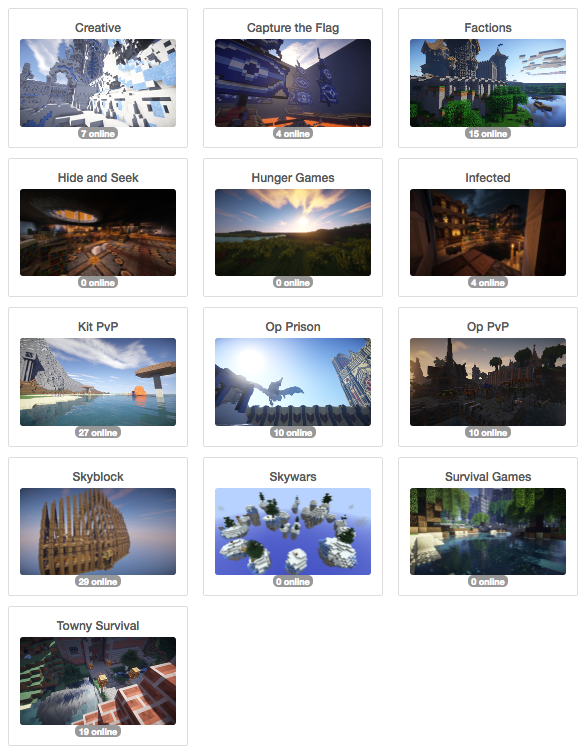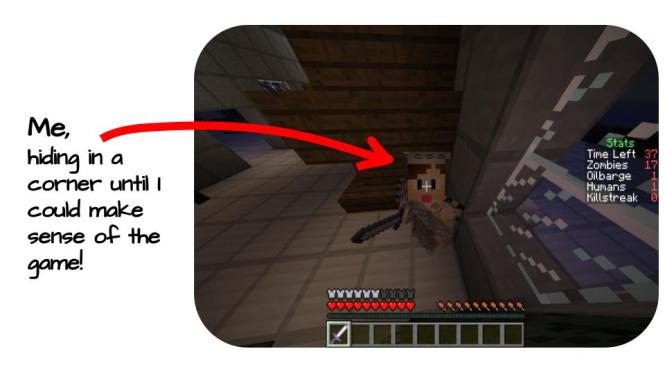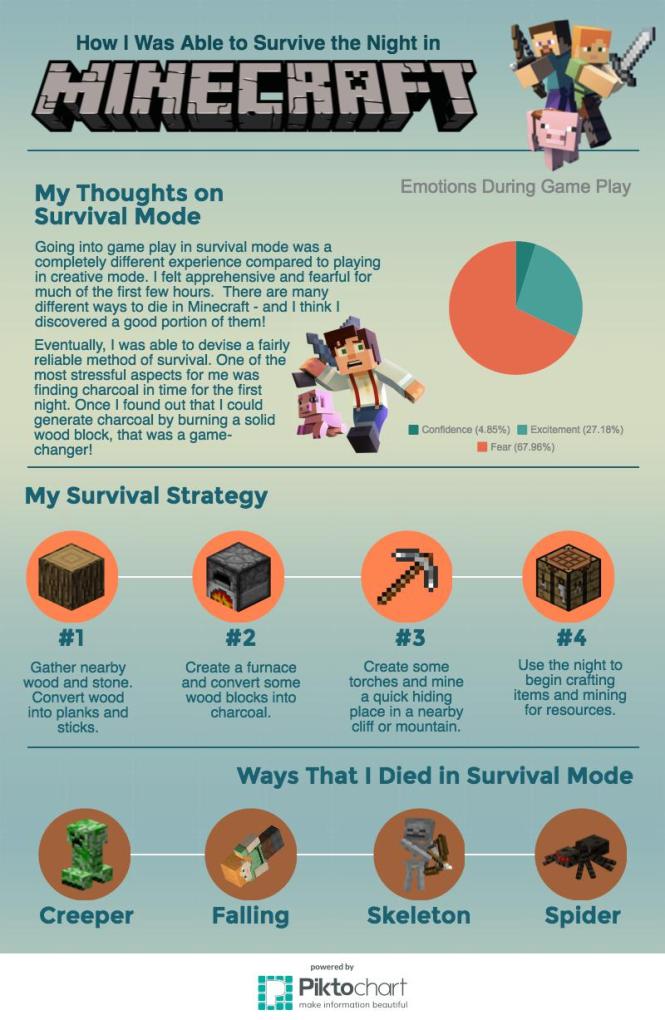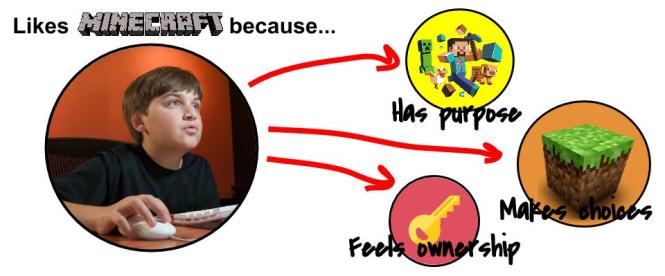|
I discovered that the world of Minecraft has a dark side! This week I explored some public servers and engaged in different types of environments with multiple online players. A Google search led me to Emenbee Realms, which hosts several different Minecraft servers for various types of game play. When I saw that the creator of Emenbee had posted rules, I decided to read them because I’ve never played on a public server before and I didn’t want to unknowingly commit some type of gaming faux pas. The rules were full of abbreviations that I didn’t understand and I spent a fair amount of time Google’ing various terminology. Since Emenbee publicly posts punishments for those who disobey the rules of the server, I was glad that I decided to play it safe. There were many server options for players to choose from, ranging from familiar (“Hunger Games”) to mysterious (“Skywars” and “Prison OP”). Since I have come to enjoy Minecraft survival mode, I decided to try out one of the survival games…and that’s where I discovered the dark side. It turns out that serious Minecraft survival gamers are mostly about killing everyone and everything in sight. There were no explicit rules for game play that I could see, beyond the generalized safety and social rules presented on the main Emenbee site. Being teleported into the middle of game play was overwhelming! Since I’m a fan of The Walking Dead TV show, I decided to join a game called “Infected.” My reaction? Wow. It took me a while to figure out that the object was to kill players of opposite teams, and that teams were designated by armor, weapons, and whether or not you had been exposed to the zombie virus. Initially, I felt like everyone was attacking me. (I died a half dozen times before I figured out that I had to hit the ground running or risk being taken out after twenty measly seconds.) My response to the attacks was to try to attack everyone else first as soon as I teleported, but that wasn’t the correct strategy either. I attacked some of my teammates, who weren’t particularly pleased. Eventually, I decided to just hit the ground running and hide until I could figure out which team I was on, who I should be killing, and how to avoid the zombie infection. I’m not sure that I was ever particularly successful, but I did manage to avoid death for five whole minutes during one round. Other servers in Emenbee Realms that I explored included the Creative server, which had some impressive builds, and a Towny survival game, which once again included lots of running around and killing. The difference between the Infected survival game and the Towny survival game was mostly the setting – the latter took place in an urban environment, while the Infected game took place mostly within a maze.
My previous experiences with Minecraft have been mostly solitary, aside from playing several simulations with out my EDTECH 531 class. The most refreshing, interesting aspect of this quest was the interaction I had with other players. A few times I battled zombies alongside others and the feeling of intense cooperation was kind of exhilarating! I will definitely continue to explore public servers in the future. This experience has added a whole new dimension to Minecraft for me. I continue to contemplate how I can translate Minecraft into my classroom.
0 Comments
As I learn more and more about Minecraft and how it can be implemented with students, I finally reached the point where I realized that I need to spend a lot more time immersed in this virtual world. So, I spent the last few weeks developing my gaming proficiency in MC and I have to say - I love it. There's a concept in gaming referred to as a state of "flow." Flow is a headspace of heightened productivity, wherein many great things are accomplished and the idea of NOT continuing the game seems impossible. Experiencing the state of flow has helped me have greater empathy for my students. Of course traditional learning environments can pale in comparison to the challenge and excitement that virtual worlds can offer! This begs the question - why not make school more like a game? I'm not just talking about the gamified elements offered by Classcraft or badges. I'm talking about full on immersion in a virtual space. As I continue to think on what that could look like in my classroom, in my content area, with my students, here's an infographic I designed about my MC experience thus far: You can view the high resolution version of this graphic on Piktochart.
As a Language Arts and Social Studies teacher, I am always interested in helping kids connect with books. One of my goals each year is to motivate kids to become lifelong readers. I always operate under the assumption that, if they are not enthusiastic readers, they simply haven’t found the right book yet. Tapping into student interests for novel studies helps, as well as choice reading during literature circles. But there are always a few kiddos for whom reading is still a chore. Colleagues and I have discussed the fact that most of our students have a very low exposure to print in the home setting; in addition, nearly half of all of our students are English Language Learners, which can also be challenging. All of this means that some of our students have a very complicated relationship with the task of reading. In the quest Virtual Worlds and Reading Levels, I read an article from Wired called “How Video Games Like Minecraft Help Kids Learn to Read.” It is actually an article I have read before, back when I first started hearing about Minecraft as an education tool. The main theme of the article is that students will read and engage with complex text when they are highly motivated to do so. They will successfully decode words and make meaningful content connections when the reading task and purpose appeals to them. Essentially, this article contends that students view Minecraft as a passion project and they are willing to go to great lengths to learn about the game and be successful while playing. Many players even feel compelled to generate content to help others play better, or fictional content to entertain others based on shared interest in the game. The idea that students are motivated by video games makes sense to me. Students are engaged by materials, tasks, and strategies in which they feel a vested interest. Over the years, I have used digital storytelling in my classroom extensively. Students enjoy making movies because they are amplifying their own voices. Students also love to self-direct 20% Projects (also known as 20 Time or Genius Hour), wherein they choose research topics of choice and develop new skills of choice. That really seems to be the key word – CHOICE. So much of what I have learned about video games so far involves a highly developed element of choice. Players choose quests, they choose avatars, they choose to develop skills, or try out certain strategies for game play. Video games offer authentic ownership over learning. Why not do a better job leveraging that for our students?
|
Author: Jessica PackCalifornia Teacher of the Year. CUE Outstanding Educator 2015. DIGICOM Learning Teacher Consultant. 6th Grade Teacher. Passionate about gamification, Minecraft, digital story-telling, and fostering student voices. Download:Archives
June 2020
Categories
All
|






 RSS Feed
RSS Feed